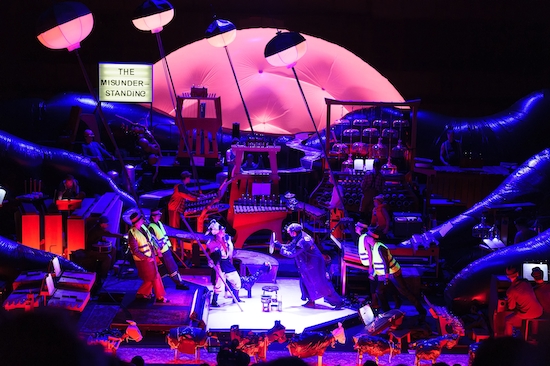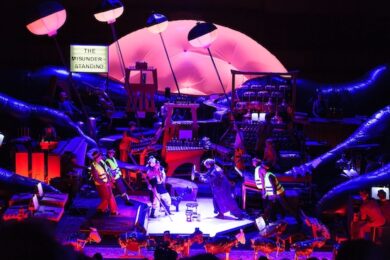When Tom Waits hung his nightclub barfly shtick out to dry in favour of something more primal with his 1983 Swordfishtrombones album – as Tristan Bath made clear in a thirtieth anniversary study of the album in the Quietus in September 2013 – it was composer Harry Partch who in part liberated Waits’ muse. Partch, who died in 1974, built his own instruments with extravagantly other-worldly sounding names such as the Chromelodeon and the Quadrangularis Reversum. He also worked with micro-tonal scales that ditched western systems for more exotic-sounding sonic provocations gleaned from Africa and Japan.
Partch’s interest in the East may have been voguishly in keeping with the trappings of post World War II modernist esoterica, but his interests in ancient Greek drama and Japanese Noh theatre lent his increasingly ambitious fusions of sound, song and spectacle a classical formality that gave what was effectively the original junkyard orchestra a gravitas whilst retaining a sense of fun.
Other artists have made their own instruments, from Max Eastley’s environmentally driven constructions on New And Rediscovered Musical Instruments, an album shared with David Toop and released on Brian Eno’s Obscure label in 1975; to the Heath Robinsonesque contraptions built today by Glasgow-based artist and performer, Sarah Kenchington.
But beyond Waits and co, Partch’s influence, whether consciously realised or not, is alive and kicking in a latter-day generation of artists intent on reclaiming music from push-button facsimiles of sound generated by the all-pervasive laptop and bringing it back to its raw, more physically primal state. These influences trickled into Edinburgh’s festival season this August both at its outer edges and its official face, counterpointing each other in a way that reflected Partch’s own contrary tendencies as a wilful outsider who nevertheless subverted the mainstream.
This could be heard in the dervish-like Afri-delic dancefloor voodoo of Glasgow band Golden Teacher, who let rip their percussion-heavy brand of delirium at the city’s Summerhall venue (which is also currently hosting an exhibition by another musical primitive, Genesis Breyer P-Orridge, alongside s/her late partner in pandrogeny, Lady Jaye Breyer P-Orridge). This was on a bill promoted by the adventurously inclined Braw Gigs operation and shared with Awesome Tapes From Africa and Optimo’s JG Wilkes at the controls.
Partch’s influence also manifested itself in an appearance by the spectrally inclined Part Wild Horses Mane On Both Sides at the artist-run Embassy Gallery, currently situated in a large basement space beneath a Yoga studio. The location was all too appropriate for PWHMOBS’ Manchester-based duo of Kelly Jayne Jones and Pascal Nichols’ presentation of Conduit of the bottomless submundane, a two hour conceptual piece played in the dark by an expanded quartet with the audience in repose on yoga mats.
With speakers, drums and assorted tables full of electronic kit, found objects and assorted detritus placed around the room, the four players moved around the space, utilising percussion and flute patterns woven around looped compositions. The result was a Zenned-out form of immersive anti-theatre that left space enough for the audience to create their own narratives, whilst retaining formal enough structures to bolster the improvisations and allow them to breathe beyond any notions of an old-time chill-out room sensation.
It was Partch’s work itself that book-ended August in Edinburgh on the grandest of scales in a major staging of his rarely performed music theatre piece, Delusion Of The Fury. Fusing two life-and-death myths derived from Japan and Ethiopia into one seventy-two minute work utilising some twenty-seven instruments, in presentation, scale and delivery, Delusion Of The Fury was the antithesis of Conduit of the bottomless submundane. Where discretion and understated intensity was at the heart of Conduit of the bottomless submundane, Delusion Of The Fury was as much visual spectacle as aural.
Or at least that was the case in the Edinburgh International Festival production, first seen in 2013 at the Ruhrtriennale International Festival of the Arts in north-west Germany performed by the Cologne-based Ensemble MusikFabrik and overseen by German composer, theatre director and maverick auteur, Heiner Goebbels.
Given that Goebbels spent much of the 1980s and early 1990s playing in Cassiber, a quartet formed
with guitarist Christoph Anders, sax player Alfred Harth and Henry Cow drummer and percussionist Chris Cutler in an attempt to fuse punk, free jazz and classical music, he was a natural fit for Delusion of the Fury’s long overdue revival.
Composed by Partch in 1966 and subtitled ‘A Ritual Of Dream And Delusion’, Delusion Of The Fury was performed for one night only at UCLA in 1969 in a version conducted by percussionist Danlee Mitchell, who would go on to become Partch’s heir. The recording of the performance was released on record in 1971, and later on CD in 1999, though both are hard to come by. A film of the performance also exists, as one hopes there is too of the Edinburgh dates, although the King’s Theatre ushers were as diligent in staving off mobile-phone wielding souvenir hunters as stewards keeping tabs on Kate Bush’s current twenty-two night adventure in musical theatre.
The comparison is not a facetious one. In the unlikely event that Bush ever graces the stage again following her similarly portentously named Before The Dawn shows, she could do worse than get Goebbels on board to co-ordinate theatrics rather than an old-school RSC man.
Before a note was even heard in Edinburgh, the elaborate network of hand-crafted musical jumble onstage looked to have been beamed down from a space age that had reclaimed the ancient. Its symmetrically arranged construction looked somewhere between Dada, Dali and Dahl in the imaginative largesse of its glass domes, custom-built keyboards and other oddities built around a small waterfall that trickled into a pool at the front centre of the stage. As overblown as a Hammer horror flick as it was, there was something child-like there too, as if Dr Phibes had rewritten Dr Seuss’ equally crazed Dr T, who built a piano so big he required five hundred small boys to play it with their five thousand fingers.
As it was, there were some twenty-two players who came on sporting an assortment of dressing-up box vintage outfits. Hi-vis jackets and lamp-lit hard-hats; street-corner trilbies and thrift-shop furs; Dead End Kid caps and Sunday-best tweeds were all in the mix. They could have been a gang of blue-collar factory trolls bashing out another shift, or a down-at-heel busking troupe peddling for change. Once they struck up the first notes of the instrumental ‘Exordium: The Beginning Of A Web’, however, things became even more playful in an eastern tinged overture of bells, scrapes, pops, clangs, busy percussive flourishes and fairground organ wheezes which at moments appeared to threaten to break into ‘Lucy In the Sky With Diamonds’, at others into Loony Tunes style cartoon cavalcades.
What followed was a Frankenstein’s monster of two knitted-together narratives, fused at the hip by a mid-section Sanctus. The first, taken from a Japanese Noh play, concerned a pilgrim in search of a shrine who finds reconciliation through death. The second, ‘On An African Theme’, told of a deaf hobo’s quarrel with an old woman and the legal battle that follows. It was the delivery that counted, however, as Ensemble MusikFabrik proceeded to leap, not just from instrument to instrument, but to acting out the scenarios with pantomimic glee by way of an eye-popping display of quirky choreography, massed Yo-heave-ho/Follow The Yellow Brick Road style chorales and dry ice.
Hooded figures knelt in a line facing away from the audience to pay homage as part of some tribal ritual, while each scene was captioned a la Brecht using a retro cinema style light box display. Not since Brix Smith clambered aboard a giant hamburger on the stage in choreographer Michael Clark’s collaboration with The Fall in ‘I Am Curious, Orange’ on the same King’s Theatre stage in 1988 has Edinburgh seen such a display of serious fun on such a grand scale.
At times it sounded akin to the spirit, at least, of the 1970s collaborations between playwright and actor Sam Shepard and theatre director Joseph Chaikin. Originally performed by Chaikin, ‘Tongues and Savage/Love fused words, physicality and an (improvised) percussion and flute score that one imagines Part Wild Horse Mane On Both Sides might also have had a hand in had they been around. There are shades too of Ennio Morricone and Bernard Herrmann at their most urgently martial.
Delusions Of The Fury’s second half was shot through with prat-fallingly good-humoured physicality, both in the musical playing and the Jungle Book joie de vivre of the performances. Cosmic-ancient science-fiction warriors square up to each other on a slow revolve in front of the fountain. Stuffed toy farm animals wrapped in bin bags and tape line the stage. Lights on tripods sway and bend like giant metronomes or dancing palm trees. Then, inbetween the flute-like trills, jaw harp and some heavy marimba-style action, a giant cut-out of a smiling Colonel Sanders takes centre stage, only for his eyes to be blinded by way of a pot of day-glo pink paint. Of course.
In terms of concept, Delusion Of The Fury was akin to spending a night in both Partch’s and Goebbels’ heads. In its increasing euphoria, it was also a gloriously audacious staging of a vital and era-defining work that needs to be witnessed as much as heard.
<div class="fb-comments" data-href="http://thequietus.com/articles/16141-live-report-delusion-of-the-fury” data-width="550">



